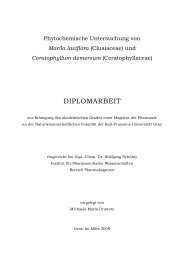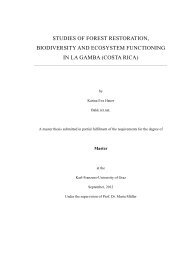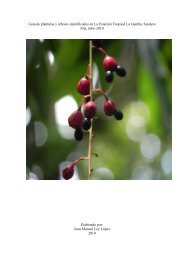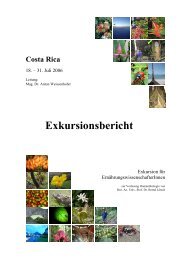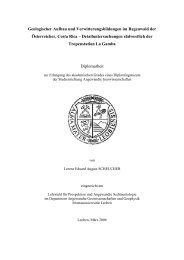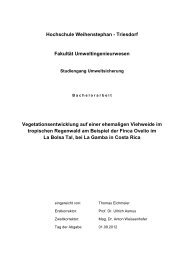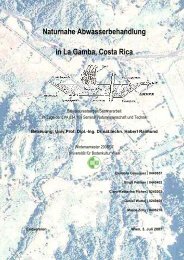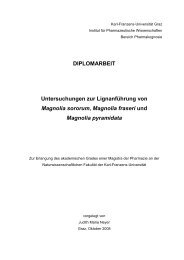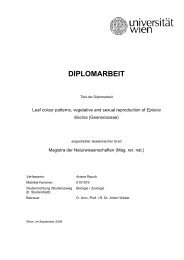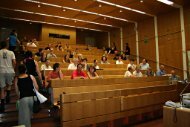Die Tropenstation La Gamba
Die Tropenstation La Gamba
Die Tropenstation La Gamba
Erfolgreiche ePaper selbst erstellen
Machen Sie aus Ihren PDF Publikationen ein blätterbares Flipbook mit unserer einzigartigen Google optimierten e-Paper Software.
<strong>Die</strong> „<strong>Tropenstation</strong> <strong>La</strong> <strong>Gamba</strong>“ in Costa Rica – Wissenschaftlicher Bericht<br />
WEBER, A., HUBER, W., WEISSENHOFER, A., ZAMORA, N., ZIMMERMANN, G., 2001:<br />
An introductory Field Guide to the Flowering Plants of the Golfo Dulce Rainforests -<br />
Corcovado National Park and Piedras Blancas National Park ("Regenwald der<br />
Österreicher"). – Linz: OÖ <strong>La</strong>ndesmuseum Stapfia 78.<br />
The rainforests of the Golfo Dulce area in southeast Costa Rica belong to the most<br />
interesting and species-rich forests in Central America. About fifty years ago, the<br />
American botanist Paul H. Allen (1956) carried out pioneering work in the region, and<br />
described the vegetation and plant diversity in the book The Rain Forests of Golfo<br />
Dulce. A proper flora covering the estimated 3000 species or more is still lacking. A first<br />
step towards such a flora was the booklet “Árboles de la Península de Osa” by QUESADA<br />
& al. (1997) which presents a brief survey on the most common trees of the Osa<br />
peninsula (with line drawings).<br />
The present "Introductory Field Guide" is an effort to make a further step. It is<br />
not restricted to trees, but covers all the commoner flowering plants, including shrubs,<br />
lianas, epiphytes, ground herbs and aquatic plants, and it is not restricted to the Osa<br />
Peninsula, but covers the whole Golfo Dulce region. This area is is now home to two<br />
National Parks: the "Corcovado National Park" (on the Osa peninsula) and the "Piedras<br />
Blancas National Park" (Esquinas Forest, including the “Regenwald der Österreicher”).<br />
For a proper flora more collecting work (especially in the more remote areas of the<br />
parks) and intensive study of special plant groups is needed.<br />
The production of the Field Guide is intimately connected with the conservation<br />
efforts of the Esquinas Rainforest and is the result of many fortuitous events. About ten<br />
years ago I became involved in the fascinating project aimed to protect a tropical<br />
rainforest. Michael Schnitzler, a distinguished musician and professor at the University<br />
of Music and Performing Arts in Vienna, had started an initiative to save the “Esquinas<br />
Rainforest” from destruction. Though the area of this forest was declared on paper as a<br />
national park (now Piedras Blancas National Park) there was still uncontrolled logging<br />
by land owners. Prof. Schnitzler founded the association “Regenwald der Österreicher”,<br />
collected over many years money in Austria and conveyed it to the Costa Rican<br />
government. With that money the government bought tracts of forest from landowners<br />
thereby saving the forest from clearance.<br />
Prof. Schnitzler showed remarkable far-sightedness in his vision for the<br />
"Regenwald der Österreicher". Not only did he promote forest protection, but he also<br />
encouraged scientific work in the forest. He first bought a small hut located at the edge<br />
of the Esquinas forest. This hut was the start of the Field Station <strong>La</strong> <strong>Gamba</strong><br />
("<strong>Tropenstation</strong> <strong>La</strong> <strong>Gamba</strong>"), which is located today in another, larger and much more<br />
comfortable, building. In Austria, Prof. Schnitzler established an advisory board<br />
consisting of Austrian scientists interested in tropical biology. I was invited to join the<br />
advisory board and so I started to search for students interested in tropical botany.<br />
Eventually I found two students who were enthusiastic and adventurous enough to tackle<br />
botanical work in the Esquinas forest: Werner Huber and Anton Weissenhofer. They<br />
used the hut as a base camp and from there they carried out studies on the floristic<br />
composition and structure of a selected plot as part of their diploma theses. In 1996 they<br />
finished their theses, but continued to work scientifically until now.<br />
Nearby the field station the Esquinas Rain Forest Lodge was constructed for<br />
eco-tourists. Thus also student excursions into the Esquinas forest became possible.<br />
During that time, the plan to produce an identification guide for common plants of the<br />
Esquinas forest was born. Initial work for the project was funded by the Austrian<br />
National Bank (Österreichische Nationalbank). Enthusiastic students joined the project<br />
and worked out some of the major families as parts of their diploma theses: Thomas<br />
Baumgartner (palms), Eva Schembera (legumes), and Sabine Will (Rubiaceae). Another<br />
diploma thesis, by Dominik <strong>La</strong>utsch was devoted to ferns and fern allies. The results will<br />
be published separately, as we had to restrict the Field Guide to flowering plants. Apart<br />
from these floristic theses, scientific work on many more aspects of the rainforest was<br />
performed during the years. A report on these activities, covering the years from the<br />
beginning (1993) until the end of 1999 can be obtained by the editors or consulted in the<br />
Internet (http://www.regenwald.at).<br />
93



